

The importance of music education in schools. This essay has been submitted by a student.
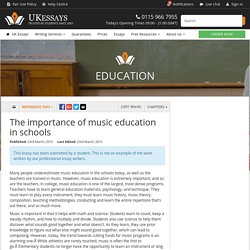
This is not an example of the work written by our professional essay writers. Many people underestimate music education in the schools today, as well as the teachers are trained in music. However, music education is extremely important, and so are the teachers. In college, music education is one of the largest, most dense programs. How important is music education in schools? Millions of children in schools enjoy music each day by singing a song during circle time, learning to play an instrument, or singing a part in a chorus.
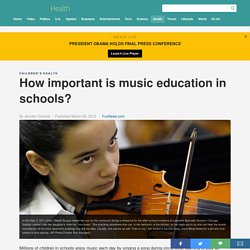
This month, musicians and music educators celebrate Music in Our Schools Month sponsored by the National Association for Music Education. Music In Our Schools Month celebrates all the benefits of having quality music education programs in schools and encourages districts to maintain such programs at a time when many face tough budgetary constraints. Music education supporters advocate the importance of exposing young children to a variety of instruments, choral arrangements, and styles of music to enhance their educational experience and foster their academic, social, and emotional growth. These supporters insist that music is more than an enjoyable hobby – and there is some science to back up these claims. Pros and Cons of Music Education by Michele Vizzo on Prezi. The Phoenix : Pros and cons to music in school.
Pros for music in school by Megan Gustin Music in school can be very beneficial in schools.
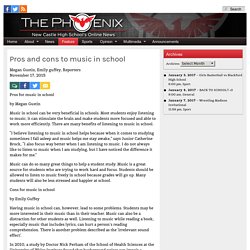
Most students enjoy listening to music; it can stimulate the brain and make students more focused and able to work more efficiently. There are many benefits of listening to music in school. “I believe listening to music in school helps because when it comes to studying sometimes I fall asleep and music helps me stay awake,” says Junior Catherine Brock, “I also focus way better when I am listening to music. Music can do so many great things to help a student study. Cons for music in school by Emily Guffey Having music in school can, however, lead to some problems. In 2010, a study by Doctor Nick Perham of the School of Health Sciences at the University of Wales Institute found that background noises can impair a person’s memory.
Serial Recall, or the ability to recall numbers, can also be affected by listening to music. What are the pros and cons of physical education? Advocates of more physical education at school point out that students spend most of their waking hours at school, making it easier to add activity there than anywhere else.
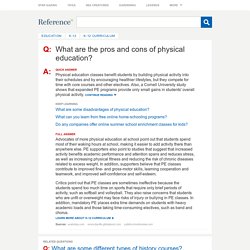
PE supporters also point to studies that suggest that increased activity benefits academic performance and attention spans and reduces stress, as well as increasing physical fitness and reducing the risk of chronic diseases related to excess weight. In addition, supporters believe that PE classes contribute to improved fine- and gross-motor skills, learning cooperation and teamwork, and improved self-confidence and self-esteem. Critics point out that PE classes are sometimes ineffective because the students spend too much time on sports that require only brief periods of activity, such as softball and volleyball. They also raise concerns that students who are unfit or overweight may face risks of injury or bullying in PE classes.
Learn more about K-12 Curriculum. Phys Ed in Schools: Improving Health or Breeding Bullying? - Law Street (TM) At a time when the media is full of references to rising levels of childhood obesity and Diabetes, the debate over mandating physical education classes in elementary, middle, and high schools is a particularly passionate one for many teachers, parents, doctors, and students.
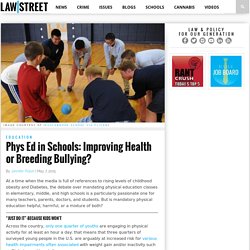
But is mandatory physical education helpful, harmful, or a mixture of both? “Just Do It”–Because Kids Won’t Across the country, only one quarter of youths are engaging in physical activity for at least an hour a day: that means that three quarters of surveyed young people in the U.S. are arguably at increased risk for various health impairments often associated with weight gain and/or inactivity such as Diabetes and heart disease. Whether it’s because of long commutes to school, piles of extra homework due to high-stakes testing, race- and class-based inaccessibility to play spaces, or the rise in mobile devices that keep many young people stationary, physical activity is often not prioritized for youths. Resources. The Pros and Cons of Physical Education in Schools. The Pros and Cons of Physical Education in Schools (Photo credit: Korean Resource Center 민족학교) The education system is designed to respond to the continuously changing needs of a dynamic society.

This need to change with society is the whole premise of education in the first place. For instance, we have seen a huge need to address technology in schools, and I believe we are steadily rising to that challenge, despite the many financial and other obstacles which stand in the way. That being said, there is one topic in particular which is discussed quite regularly in different corners of the world and by various media outlets…namely…childhood obesity. Physical Education Should be Mandatory in Schools: 1. 2. The Pros and Cons of Mandatory Gym Class in Public Schools. Leaders debate the pros and cons of mandatory gym classes in public schools.

Learn more about the controversy and whether gym class should be a phenomenon of the past. Gym class is invariably portrayed on the silver screen as a time of awkwardness and embarrassment, when kids have to climb ropes and do a certain number of push-ups in a minute’s time. However, gym class is much different now, and it is not surprising that today’s students and parents are questioning why it’s even a mandatory part of the day.
After all, according to a MSNBC investigation, researchers have found that the average high school gym class only keeps students physically active for an average of 16 minutes! In a class period that is about 45 minutes long, that isn’t a lot of active time. Supporters of mandatory gym programs contend that physical education classes have a wide range of benefits. Subsequently, some school leaders are left without a clear answer in the debate. Should Schools Discontinue Gym Classes?